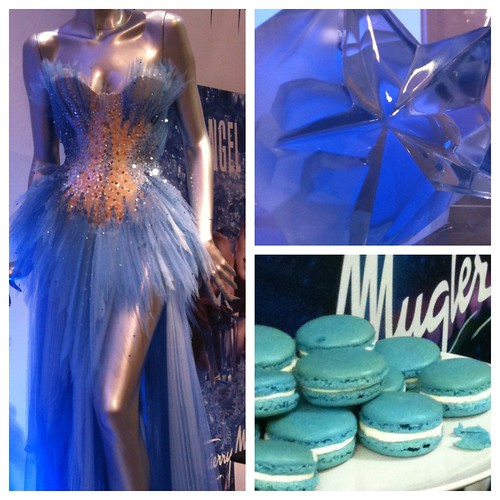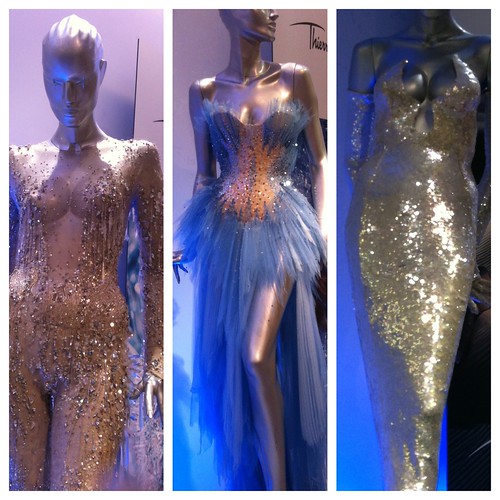Gourmands: Main Course or Dessert?
The "Dessert" of the Oriental Week this past Friday was an afternoon dedicated to Gourmand perfumes - a modern sub-category of the Oriental fragrance family. This relatively recent trend turned into an established genre beginning with Thierry Mugler's Angel. This cult perfume was created for avant-garde fashion designer Thierry Mugler by nose Olivier Cresp in 1992, and closely followed by the iconic licorice, cherry and violet based Lolita Lempicka (designed by perfumer Annick Menardo in1997).
Angel, now one of the top five best-selling perfumes in the world, was not an immediate success. It took Thierry Mugler's devotion and deep conviction in the fragrance, matched by investing plenty of creative marketing effort into before the world warmed up to Angel - first through a cult of loyal customers who were completely addicted to its unique combination of patchouli, blackberry, helional, citrus and ethyl maltol (a novel scent molecule reminiscent of cotton candy) - and later, a world-wide loyalty to Angel as a brand, with a star-shaped refillable bottles and unusual spray mechanism, hi-tech urns for refilling in most retail locations, and many sequels, limited edition bottles, advertisement with unique haute-couture gown made for each model (some of which were celebrities).
Lolita Lempicka also belongs to a fashion house (of the same name), and like Angel it was cleverly marketed, yet with more earthly, whimsical fairytale-like visuals and connotations. The unique bottle, asymetrical apple-shaped with a stem that doubles as the spray nozzle - has highly imaginative posters and video clips to boot. It took the Lolita fantasy to a different level - while the name of the brand (and perfume) alone evokes that not-so-innocent child-woman from Nabokov's famous novel (the Lempicka part is named after the Polish painter, Tamara de Lempicka). there is more magic added to the mix in what feels very personable (if that's your taste), resonating on a rather deep level of self-identity, appealing to the artistic, whimsical girl-at-heart personality. And what did it smell like? Reminiscent of candy, but with hints of green freshness from ivy leaves and anise notes, Lolita Lempicka focuses its foody obsession on licorice candy, giving it a more floral treatment than Angel with the addition of violets, and the sweetness comes primarily from heliotropin (which smells like a very sweet cherry pie), coumarin and vanilla - evoking the scent of Amarena cherries. There is a lot more powderiness to it than Angel, and the contrasting earthy quality comes from a vetiver root.
Niche perfumeries did not escape from this trend either, with dessert-like creations such as the artificially almondy, syrupy-sweet Rahat Loukum (Serge Lutens), and cherry-like Luctor et Emergo (The People of the Labyrinth). The sweetness in these perfumes went completely overboard, even more than the vanilla and ethyl-vanillin saturated Shalimar (which is one of the first Ambery Orientals, created in 1925). The use of all of these sweet notes, and their dosage, suggested a full-calorie dessert, making them feel deceivingly edible. And both are closely related to Hypnotic Poison (1998, also created by Annick Menardo, and smells like almond and vanilla with hints of caraway).
Gourmands' inherent comforting impact is what made this fragrance category dominate the women's fragrance market well into the new millennia, providing a rather extreme counterpoint to the scrubbed-down aquatic florals of the same era. But it was in the early new millennia that gourmands really reached traction. After 9-11, the gourmands provided to the traumatized masses exactly the kind of comfort they needed: something child-like, innocent, familiar, cozy, sweet, a little simplistic even. Like a mother handing her sobbing child a square of chocolate caramel, the perfume companies went overboard with this trend, and it bled onto the other genres - tainting anything from florals (countless celebrity scents come to mind) to chypres (Fruitchouli, anyone?) with a sugary sweet cotton candy note; or one novel fruit or another.
Savoury gourmands are less talked about, and provide an interesting and more sophisticated take on culinary inspiration. While the dessert-inspired gourmands we've discussed so far relied on novel molecules to emanate the strong association of sweetness, a different trend, which is now becoming more popular, is the new obsession with "salty". But before we digress into mineral notes - let's just mention some of the earlier "savoury" gourmands - those that were designed to smell like earlier courses in the meal.
Dinner by Bobo (2002) is the first example that springs to mind. This perfume played up the cumin presence to create a rather controversial effect at the time. While cumin is popular spice around the world, and has been used in best-selling perfumes in France (in Rochas Femme reformulation, for example). many people in North America associated cumin with "sweat" and find it unsavoury. Dinner by Bobo brings to mind a candle-lit dinner in a French-Moroccan restaurant, complete with red wine - but no dessert in sight. It plays like a complex tajin with dried apricots and prunes and warm spices - not that far in concept from the fruity Chypres of the mid-twentieth century.
Serge Lutens plays up the exotic spices in its souk-evoking perfume Arabie. The notes are a lot more realistic, but still remain in a very clear context of perfume, with the edible association perhaps more known to those familiar with the complex spices used in Arabic and North African cooking. in Santal de Mysore, a similar accord of Indian curry is used in contrast to East Indian sandalwood.
Later still, Jo Malone introduced a couple of fragrances that explored a more savoury aspect of food: the Mexican inspired Blue Agave & Cacao, bringing to the fore a dusty cacao note mingled with salt, lime and blue agave. Sweet Lime & Cedar was inspired by Thai cuisine, and at its core is kaffir lime leaf mingled with coconut water and cedarwood. Again - not a sweet interpretation (although coconut could have brought it easily all the way to the realm of celebrity scents, Malibu beach style). Last but not least: Anima Dulcis presents its cacao notes alongside cumin, cinnamon, vanilla, salted caramel and chili. It's not exactly sugar-free, but it balances all of the sweet and savoury elements so well, that it won my heart completely.
Here are some of the most famous if not influential Gourmand fragrances:
Angel (1992)
A*Men(1996)
Lolita Lempicka (1997)
Lolita Lempicka Au Masculin (2000)
Wish (Chopard)
Rochas Man
Hanae Mori Butterfly
Pink Sugar (Aqualina)
Popi Moreni
Yohji
Yohji Homme
Rahat Loukum (Serge Lutens)
Luctor et Emergo (The People of the Labyrinth)
Rahat Loukum (Serge Lutens)
Rosewater & Vanilla (Jo Malone)
Hypnotic Poison (Dior)
Réglisse Noire (1000Flowers)
Savoury Gourmands of Interest:
Dinner by Bobo
Arabie (Serge Lutens)
Santal de Mysore (Serge Lutens)
Blue Agave & Cacao (Jo Malone)
Sweet Lime & Cedar (Jo Malone)
Anima Dulcis (Arquiste)





